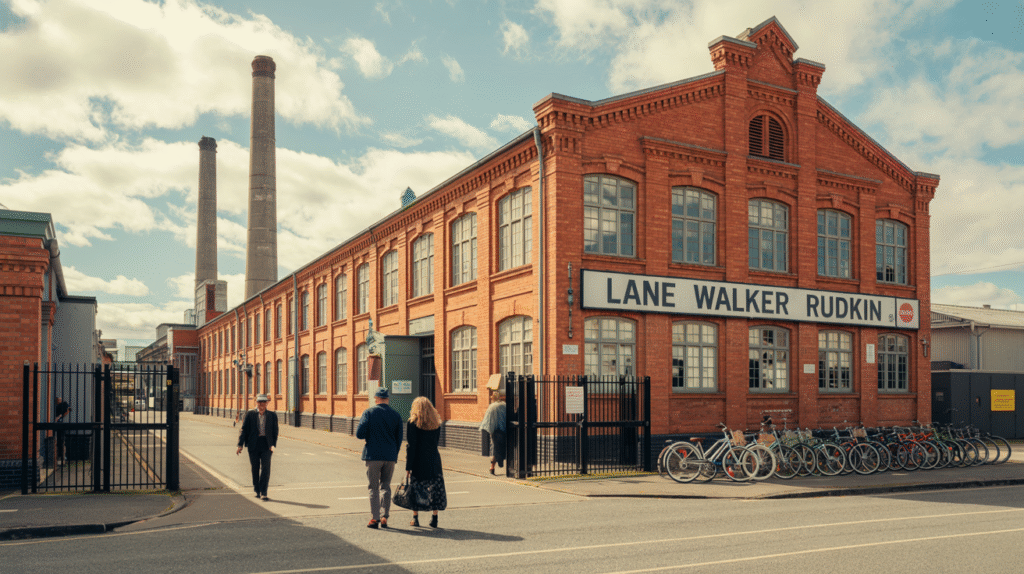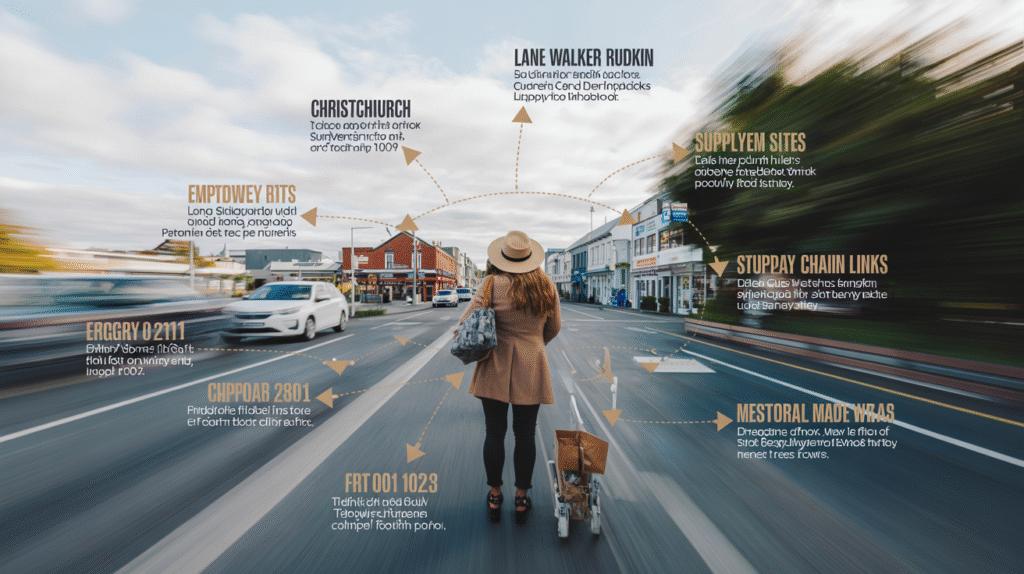
🏙️ Introduction: The Industrial Heart of Christchurch
For much of the 20th century, Christchurch was more than just the largest city on New Zealand’s South Island—it was a hub of industry, innovation, and community. At the center of that economic engine stood a name synonymous with local craftsmanship: Lane Walker Rudkin.
As the company’s founding location, Christchurch wasn’t just where LWR was born—it was where it evolved, thrived, and built its legacy across generations. From its modest beginnings as a small garment manufacturer to a multi-site enterprise exporting globally, LWR and Christchurch were intertwined in both business and culture.
🧵 Founding in Christchurch: The Early 1900s
Lane Walker Rudkin & Co. was officially established in 1904, in the heart of Christchurch. Its original operations focused on hosiery and underwear production, drawing on the city’s:
- Access to wool supply chains
- Skilled and trainable workforce
- Strong infrastructure, including rail and shipping routes
- Proximity to schools, military, and institutional clients
The company’s first facility, located on Lichfield Street, quickly became a recognizable part of the city’s growing industrial sector.
🧶 “Christchurch gave LWR more than just a factory—it gave it purpose, people, and place.”
🧑🏭 Workforce Development and Local Employment
LWR was one of the largest employers in Christchurch throughout much of the 20th century, especially for women. The company was known for:
- On-the-job training for machinists and textile workers
- A structured work environment with career progression
- Supporting women entering the workforce during and after both World Wars
By the 1950s, LWR’s Christchurch workforce included:
- Machine operators
- Pattern cutters
- Dye house workers
- Packing and logistics teams
- Clerical and administrative staff
Local high schools often saw graduates go straight into roles at LWR, where they would work for decades, sometimes alongside parents or siblings.

🏗️ Factory Expansion and Infrastructure
As demand grew, LWR expanded its Christchurch operations into multiple buildings and specialized departments. By the 1960s, the company’s footprint in the city included:
- The main production plant with cutting and sewing floors
- A dye house and fabric treatment facility
- Warehousing and shipping docks for national distribution
- A modest R&D center for fabric testing and product development
The architecture of LWR’s Christchurch sites reflected a mix of early 20th-century industrial design—high ceilings, large brick facades, wide loading bays—paired with newer prefab extensions as technology evolved.
🏭 Today, many former LWR buildings still stand, some repurposed into co-working spaces, galleries, and lofts—echoes of a once-bustling manufacturing past.
🔁 Integration into Christchurch’s Civic Life
Lane Walker Rudkin was never just a place to work—it was part of the social identity of Christchurch.
Community Involvement:
- Sponsored local sports teams
- Hosted holiday parties, fashion shows, and family days
- Organized employee softball leagues and sewing competitions
- Provided scholarships and training grants for promising students
Christchurch residents saw LWR not only as a job provider but as a company that invested in people.
🧵 “My mum, aunt, and cousin all worked at LWR. It’s where our family stories begin,” said one local in a 2010 retrospective interview.
🧠 Training and Education
To support its expansion, LWR implemented in-house apprenticeship programs and collaborated with Christchurch Polytechnic and local high schools.
Topics included:
- Garment construction techniques
- Textile chemistry (for dyeing and fabric treatment)
- Industrial safety
- Production management
- Emerging CAD/CAM technologies in apparel design
📘 LWR even provided technical manuals and training videos decades before digital learning platforms became popular.

💰 LWR’s Role in Christchurch’s Economy
Lane Walker Rudkin wasn’t just one of the city’s biggest employers—it was a pillar of Christchurch’s mid-century economy. The company’s activities had ripple effects through:
📦 Local Supply Chains:
- Wool from Canterbury farms
- Dyes and chemicals from nearby industries
- Labels and packaging from regional printers
- Transportation via local trucking and rail services
💼 Employment:
At its height, LWR employed over 400 people in Christchurch alone. During peak production periods, the company operated multiple shifts, six days a week. It became a stable source of income for thousands of families, especially in working-class neighborhoods like Sydenham and Addington.
🏠 “When someone in your household worked at LWR, you could pay your rent and send your kids to school.”
🧵 LWR During Social Change and Wartime
As Christchurch—and the world—transformed during the 20th century, Lane Walker Rudkin adapted. It was shaped by, and helped shape, the social evolution of labor, gender roles, and national identity.
🔧 During World War II:
- LWR produced military uniforms and undergarments for the New Zealand Defence Force.
- Many male staff left to serve, and women filled the gaps, often taking on technical roles for the first time.
- The company adopted wartime production discipline, including blackout protocols and rationing adaptation.
This marked the beginning of a permanent shift toward female employment in the textile sector.
👩🔧 Women in the Workforce
LWR was a rare company that embraced women as long-term skilled labor. In postwar Christchurch, it offered:
- On-site childcare services in some locations
- Promotions to supervisory roles
- Skills training beyond basic sewing (e.g., machinery maintenance, planning)
By the 1970s, women made up over 80% of LWR’s Christchurch factory workforce, contributing not just labor but technical and leadership expertise.

🗣️ Labor Unions and Employee Rights
The growth of LWR coincided with the rise of organized labor movements in New Zealand. Workers at the Christchurch sites were often:
- Unionized under the Textile Workers’ Union
- Actively involved in wage negotiations and workplace safety reforms
- Engaged in company-wide decisions, especially in the 1970s and 1980s
🧠 LWR became a model of collaborative employer-union dynamics, resulting in relatively few strikes and high staff retention.
🏗️ Urban Impact: Shaping Christchurch’s Cityscape
As Lane Walker Rudkin expanded through the 20th century, it didn’t just grow its payroll—it reshaped Christchurch’s physical and economic landscape.
🏭 Industrial District Growth
LWR’s facilities helped develop areas like:
- Sydenham (main production floor)
- Addington (fabric finishing and shipping)
- Woolston (logistics and dye processing)
These neighborhoods became hubs of working-class life, with cafes, boarding houses, laundromats, and public transport routes built around shift schedules.
🚊 Transportation Integration
LWR’s Christchurch factories were strategically placed along:
- Tram and train lines
- Cycling corridors used by hundreds of workers daily
- Truck-accessible warehouses, allowing fast national distribution
The company even organized bus services for staff commuting from outer suburbs during peak production seasons.

🏘️ Housing & Infrastructure Influence
- Employee housing schemes: Some LWR employees purchased homes near factory sites through union partnerships.
- Community support: LWR frequently donated to local hospitals, schools, and religious organizations.
- Youth employment: High schools collaborated with LWR for job placements and holiday work.
🏘️ In many ways, LWR acted as a quasi-civic institution, influencing urban growth and social support beyond the factory walls.
🧬 LWR and the Cultural Identity of Christchurch
For nearly a century, Lane Walker Rudkin was more than just a factory—it was part of Christchurch’s DNA. It influenced how the city saw itself and how others perceived it.
🎯 Identity Through Industry
Christchurch was often referred to as the “manufacturing capital of the South Island,” and LWR was a significant contributor to that reputation. The company’s success symbolized:
- Local pride in New Zealand-made goods
- A commitment to quality craftsmanship
- Progressive attitudes towards labor and innovation
- A model of community-centered capitalism
LWR uniforms, sportswear, and school kits became part of New Zealand’s collective wardrobe—designed, cut, and stitched in Christchurch.
🏉 National Recognition Through Sport
With the rise of Canterbury of New Zealand, LWR’s presence extended well beyond the city. Christchurch became known as the birthplace of one of the world’s most recognizable rugby apparel brands.
- All Blacks jerseys manufactured at Christchurch sites
- International teams wore garments “Made in NZ”
- Fans and athletes connected the quality of gear to its Christchurch origin
Even decades later, older generations in New Zealand still associate their sports kits—and their childhood uniforms—with the LWR Christchurch production lines.
⚠️ The Closure: Citywide Shockwaves
When Lane Walker Rudkin went into receivership in 2009, the impact on Christchurch was deeply personal and deeply public.
👥 Community Reaction
For many families, it meant:
- Immediate job loss
- Uncertainty around pensions and unpaid wages
- Loss of routine, dignity, and social networks built at work
📰 Media Coverage
Christchurch media outlets ran front-page stories:
- Interviewing long-time machinists
- Reporting on empty factories and shuttered doors
- Investigating the financial collapse and mismanagement
🗞️ Headlines like “End of an Era: LWR Shuts Down Christchurch Hub” reflected the emotional blow.
📉 Economic Effects
- Suppliers, couriers, maintenance workers—entire ecosystems around the factory lost clients
- Retailers lost local product lines they had sold for decades
- Christchurch’s identity as a textile manufacturing stronghold took a hit
The closure also coincided with the 2008 global financial crisis, compounding economic hardship for many households already under pressure.

🏛️ Preservation and Public Memory
Despite the collapse, efforts to preserve Lane Walker Rudkin’s legacy in Christchurch began almost immediately.
🧳 Museums and Archives
The Canterbury Museum and other regional historical groups began collecting:
- Uniforms and fabric swatches
- Product catalogs
- Factory equipment
- Internal training manuals and memos
These artifacts were used in temporary exhibitions, many of which explored:
- The role of women in industry
- Mid-century working-class life
- The evolution of “Made in NZ” brands
🎙️ Oral History Projects
Local universities and heritage organizations recorded dozens of interviews with former workers. These conversations documented:
- Life inside the factory
- Changes in production methods over time
- Employee experiences during the collapse
- Multigenerational stories of family employment
🎧 Many of these recordings are now housed in public audio archives, offering researchers insight into Christchurch’s social history.
🧱 Adaptive Reuse of Factory Buildings
Rather than demolish the old factory sites, several LWR buildings in Christchurch were:
- Transformed into startup hubs and coworking spaces
- Converted into loft-style apartments and creative studios
- Used for community events and exhibitions preserving industrial architecture
🏢 A former dye house is now a craft brewery. A cutting room? A tech incubator. The bones of LWR still support Christchurch in new ways.
📚 School Programs and Local History Curricula
Christchurch high schools began incorporating LWR into their social studies and economics classes, using it as a case study for:
- Industrial growth and decline
- Labor rights movements
- The effects of globalization on local business
- Gender and work
This helped young Christchurch residents understand their city’s industrial roots and engage with their community’s transformation.
🧠 Historical Significance: What Lane Walker Rudkin Means Today
To understand Christchurch’s past is to understand Lane Walker Rudkin’s impact. For many decades, the company was a symbol of:
- Steady employment
- High-quality local production
- Social mobility, especially for women
- Community-driven industry
Today, even in the absence of operating factories, LWR remains a part of Christchurch’s collective identity.
🧵 From Fabric to Memory
While modern Christchurch is shaped by technology, tourism, and post-earthquake reconstruction, its industrial past still echoes in:
- The design of re-purposed LWR buildings
- Family stories passed down from machinist grandparents
- Local sports kits that once bore LWR’s craftsmanship
- Archives preserving catalogues, uniforms, and tools
🧷 In a city often defined by resilience, LWR stands as a cultural artifact of how Christchurch once stitched together economy, society, and progress.
🏡 LWR’s Footprint in Modern Christchurch
Even decades after its closure, the company’s physical, economic, and cultural imprint remains visible:
- Former LWR neighborhoods like Sydenham and Addington still have street names, buildings, and facilities linked to the company
- Many elder residents still refer to factories by their LWR division names
- Weekly markets in former industrial zones often sell vintage LWR garments
There are also Facebook groups and local forums where ex-employees share old photos, plan reunions, and reminisce about “the LWR years.”
🌍 Lessons from LWR for the Future of Local Industry
Christchurch’s relationship with LWR teaches future entrepreneurs and policymakers that:
- Community-first industry can thrive with the right vision
- Training and upskilling are key to long-term economic health
- Worker respect and empowerment boost longevity
- Branding must match internal strength and operational transparency
📘 In university business classes, Lane Walker Rudkin is now taught not only as a success story—but also a cautionary tale.
